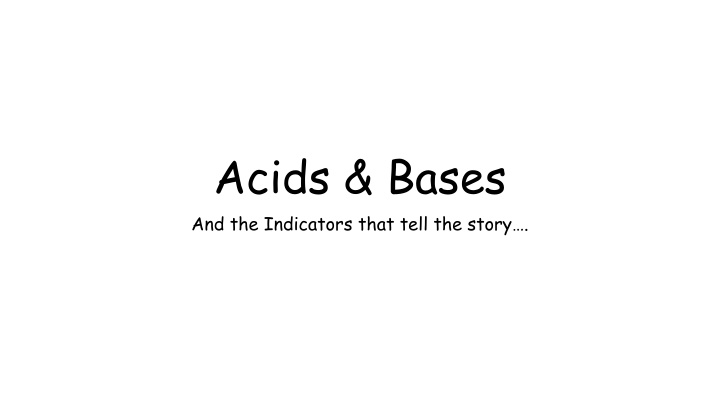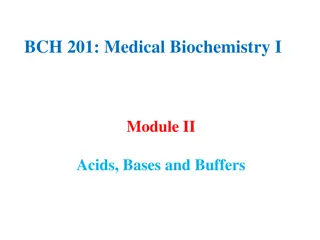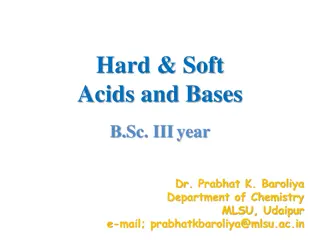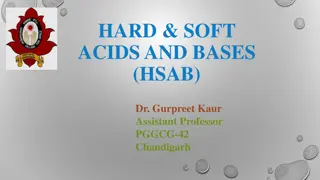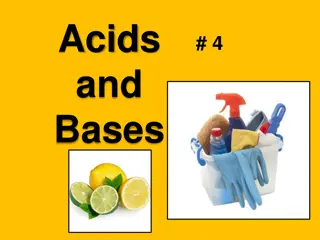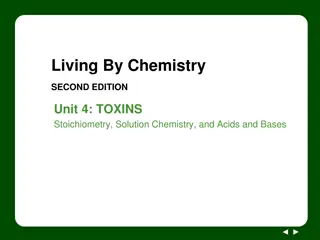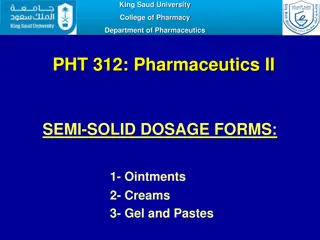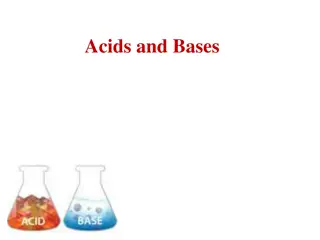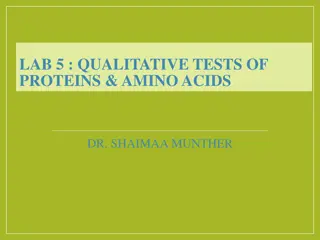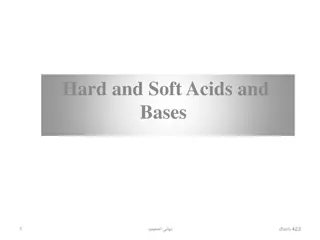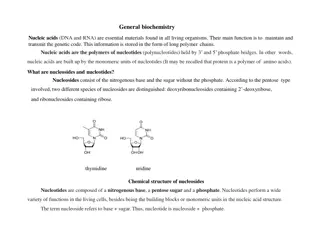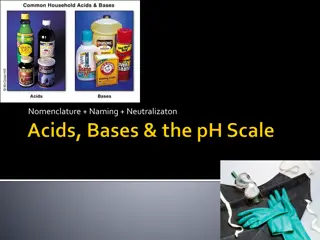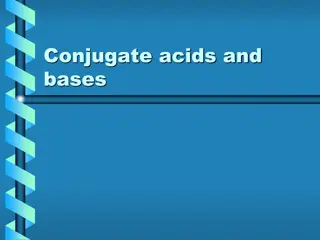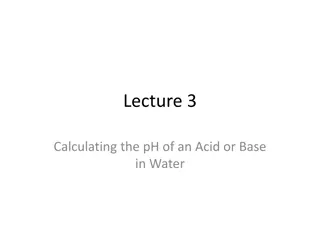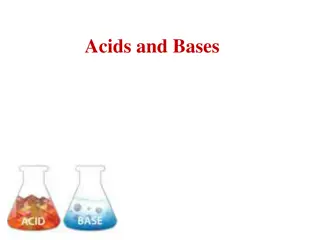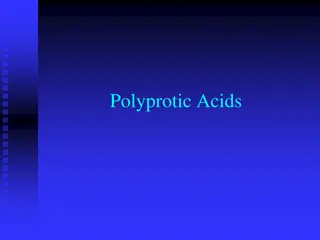Acids, Bases, and Indicators - The Story of pH
Acids and bases are defined by their pH levels, with acids having more H+ ions and bases having more OH- ions. The pH scale ranges from 0 to 14, determining acidity and alkalinity. Acids taste sour and conduct electricity, while bases feel slippery and taste bitter. Explore the characteristics and formulas of acids and bases to understand their properties better.
Download Presentation

Please find below an Image/Link to download the presentation.
The content on the website is provided AS IS for your information and personal use only. It may not be sold, licensed, or shared on other websites without obtaining consent from the author.If you encounter any issues during the download, it is possible that the publisher has removed the file from their server.
You are allowed to download the files provided on this website for personal or commercial use, subject to the condition that they are used lawfully. All files are the property of their respective owners.
The content on the website is provided AS IS for your information and personal use only. It may not be sold, licensed, or shared on other websites without obtaining consent from the author.
E N D
Presentation Transcript
Acids & Bases And the Indicators that tell the story .
Acids & Bases are Based on WATER! Depending on the amount of H+ or OH- ions, the water becomes either acidic or basic (aka alkaline) The pH scale determines the strength of the acid/base The pH scale runs from 0 -14 Low numbers are acidic High numbers are alkaline 7 is neutral Water
Acids Acids are a chemical substance which contains more H+ ions than OH- ions. An acid is able to donate electrons H+ is called Hydronium The more H+ ions in solution, the stronger the acid.
Bases (Alkali) Bases are a chemical substance which contains more OH- ions than H+ ions. A base is able to accept electrons OH- is called hydroxide The more OH- ions in solution, the stronger the base.
Characteristics of Acids Taste Sour Conduct Electricity Corrosive, which means they break down certain substances. Many acids can corrode fabric, skin and wood Some acids react strongly with metals Turns blue litmus paper red Turn pH Paper Yellow Red Depending on strength of acid
Acids Remember Acids are solutions with a higher amount of Hydrogen ions (H+) 99% of the time, their formula begins with H (which stands for the Hydrogen ion) HCl = Hydrochloric Acid HNO3 = Nitric Acid H2SO4 = Sulfuric Acid
Characteristics of Bases aka - Alkalis Feel Slippery (Think SOAP!) Taste Bitter Corrosive (Just as corrosive as Acids!) Can conduct electricity. (Think alkaline batteries.) Do not react with metals Turns red litmus paper blue Turn pH paper Green Blue Turn Phenolphthalein Pink/Magenta
Bases Remember Basic (Alkali) solutions have a higher amount of Hydroxide ions (OH-) 99% of the time, their formula ends with OH (which stands for the Hydroxide ion) NaOH = Sodium Hydroxide KOH = Potassium Hydroxide Ba(OH)2 = Barium Hydroxide
To Neutralize Neutralization is a chemical reaction in which an acid and a base react with each other In a neutralization reaction, the point is to bring the solution back to equilibrium No excess of hydrogen or hydroxide ions present in solution One H+ for each OH- H+ OH = Water! (Which is neutral)
Neutralization To neutralize (counter-act) an acid, you add a base To neutralize (counter-act) a base, you add an acid A Neutralization Reaction always produces a salt and water! Acid + Base = Salt + Water Neutralization is a type of Hydrolysis (breaking something apart and producing water (hydro) as one of the products)
Salts A salt is formed between the reaction of an acid and a base Usually, a neutral salt is formed when a strong acid and a strong base are neutralized in the reaction The H+ is removed from the acid and the OH-is removed from the base H + OH = H2O The other elements combine to form a salt A salt is an ionic compound which is made up of two groups of oppositely charged ions A Metal + A Non-metal
Salts CAN BE acidic or basic (or neutral)! Adding a strong acid to a strong base should bring the pH of the solution back to neutral A salt formed between a strong acid and a weak base is an acid salt A salt formed between a strong base and a weak acid is a basic salt
What happens when What happens when a solid salt solution is dissolved in water? It is hydrolyzed (broken down) into an acid and a base Example: NaCl (Sodium Chloride) Table Salt In water, it is broken into Na+ and Cl- ions The Sodium (Na) metal and a Hydroxide ion (OH) combine to form a base (NaOH) The Chlorine (Cl) non-metal and a Hydrogen ion (H) combine to form an acid (HCl)
Indicators Acid - base indicators (aka pH indicators) are substances which change color in different pH levels There are many different types of indicators: Litmus Paper (Red & Blue) pH Paper Universal Bromothymol Blue Thymol Blue Methyl Orange Phenolyphthalein Bromocresol Green
Indicator Red Litmus Blue Litmus Universal Indicator Acid Blue Red Neutral Base Red Blue Red/Brownish Green Blue/Violet Bromothymol Blue Yellow Green Blue Methyl Orange Phenolphthalein Thymol Blue pH Paper Red Orange Yellow Clear/Colorless Red Reddish/Brown Pink/Magenta Blue Navy Yellow Green
